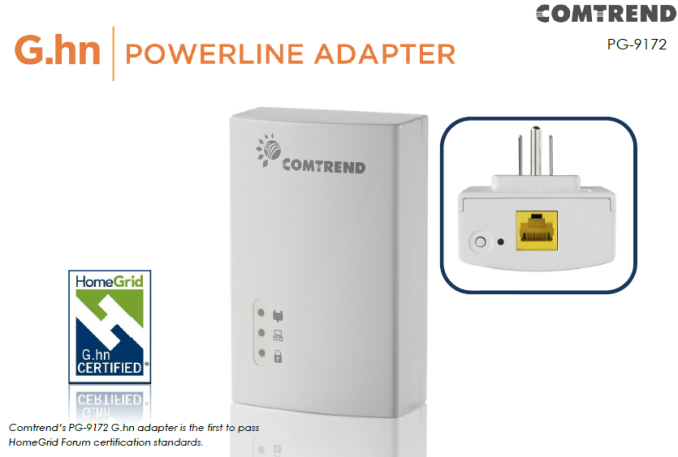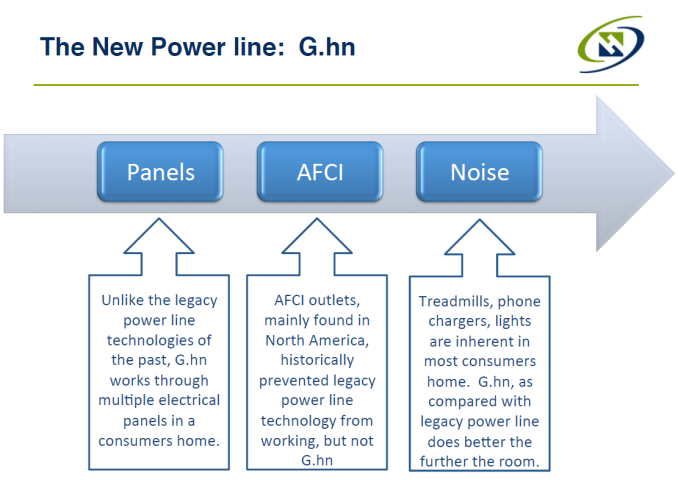Comtrend PG-9172 Powerline Adapter Review: G.hn Gets Primed for Retail Push
by Ganesh T S on May 3, 2016 8:30 AM EST- Posted in
- Powerline Adapters
- Networking
- Marvell
- G.hn
- HomePlug
- Comtrend
Concluding Remarks - What is Next for G.hn?
The Comtrend PG-9172 G.hn powerline adapter gave us the opportunity to look at G.hn technology in real-world scenarios. Our evaluation shows that the technology is quite competitive in terms of performance. It shows better resilience to noise and performs better than HomePlug AV2 products from late 2014 in almost all scenarios. In particular, AFCI circuit breakers don't seem to cause as much performance degradation in the PG-9172 as they cause in HomePlug adapters. All in all, the product delivers upon its claims and performs as expected. We hope to add some comparative numbers from the newer class of AV2000 HomePlug products in the near future.
Positives aside, Comtrend could definitely do with better default settings in the firmware (particularly for power efficiency). The firmware update process must be made more reliable. Better software QA wouldn't hurt. The HTTP interface should also be made more user-friendly with better capabilities.
It is great to finally see G.hn technology in retail. It might be painful in the short term due to initial coexistence issues, but, we can see that the G.hn side is taking a lot of effort to minimize the problems. HomePlug has a huge install base and still holds the lead, but, G.hn is no longer a vaporware competitor. That said, we would like to see more commitment to G.hn from Tier-1 vendors.
There is hardly any doubt that G.hn, considered standalone, provides a better user experience and has technical advantages. The issue has always been market acceptance and the existing install base of HomePlug demanding backwards compatibility in the pure powerline communication space.
The rising popularity of mobile devices has made Wi-Fi indispensable in the home network. However, wireless dead spots have been a major pain point for consumers. Most networking vendors have been trying to solve the wireless dead spot problem with a mixture of different products - Wi-Fi extenders, powerline adapters and other similar devices. Wi-Fi extenders usually don't deliver great user experience because the radio constantly switches between client and AP (access point) modes resulting in lowered effective bandwidth. A wired-to-Wi-Fi extender (using powerline technology) enables the extender to be in the AP mode 100% of the time, and in a different channel too. HomePlug built upon this strategy to become part of the Hy-Fi standard, aimed at making hybrid networking popular in the market. However, the Hy-Fi scheme has largely been given a cold shoulder by the market.
The HomeGrid forum and Marvell believe that the solution for a cost-effective and great user experience lies in the usage of G.hn as a backbone. The introduction of the ARRIS SURFboard RipCurrent series (a family of routers and extenders using G.hn technology) is indicative of G.hn's further push into retail channels. It is also an example of the hybrid networking idea as envisioned by the HomeGrid forum.
The announcement of the RipCurrent lineup also opens up the interoperability aspect of the Comtrend PG-9172. Given that both products are based off Marvell silicon, and both carry HomeGrid forum certifications, it shouldn't be an issue. Hopefully, our planned evaluation of the ARRIS SURFboard RipCurrent lineup will put any doubts to rest.
ARRIS is on board the G.hn train with their SURFboard RupCurrent lineup. It remains to be seen whether other Tier-1 vendors will join in. HomeGrid / G.hn seems to finally be on the right track and the momentum is now on their side. The HomePlug vs. HomeGrid tussle just got a lot more interesting.












48 Comments
View All Comments
bigboxes - Tuesday, May 3, 2016 - link
Agreed. I was able to infer that they were the same, but yes it was confusing.geniekid - Tuesday, May 3, 2016 - link
+1.spawnbsd - Tuesday, May 3, 2016 - link
HomeGrid forum is just an organization that promotes G.hn, that's all. Many of the equipment and chipset vendors building G.hn gear belong to HomeGrid forum.sor - Wednesday, May 4, 2016 - link
+1, sounds like three different competing standards in the article.Icehawk - Tuesday, May 3, 2016 - link
What is idle power after turning power saving on?mgrier - Tuesday, May 3, 2016 - link
Any chance I could get you to test latency also? This is important for competitive gamers...gobaers - Tuesday, May 3, 2016 - link
I just did a ping sweep on my Homeplug connection:Reply to request 4861 (1 ms) (size 997)
Reply to request 4862 (10 ms) (size 998)
Reply to request 4863 (10 ms) (size 999)
Reply to request 4864 (1 ms) (size 1000)
Success rate is 100 percent (4865/4865), round-trip min/avg/max = 1/5/30 ms
Mostly 1ms, but can sometimes spike. I wonder if G.hn handles this better.
spawnbsd - Tuesday, May 3, 2016 - link
Marvell's G.hn chipsets use G.hn's TDMA MAC mode, and generally always given lower (more determinstic) latency and throughput compared to CSMA based HomePlug AV/AV2 gear. Latency should always be in the ~1ms range, unless impulse noise or other interference in the home forces link layer retransmissions (which will add jitter).qlum - Tuesday, May 3, 2016 - link
I wonder how the performance of these devices differs under the European 230v/50hz compared to the us.Murloc - Thursday, May 5, 2016 - link
they're just as much finicky and dependent on where you put them in although there is no weird old wiring in most european houses.